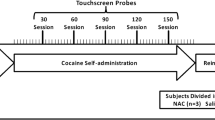Abstract
Rationale
Frequent exposure to methamphetamine has been reported to adversely influence cognitive behavior and, in particular, inhibitory control processes.
Objective
The present studies were conducted in squirrel monkeys to assess the effects of daily intravenous methamphetamine self-administration on touch screen-based repeated acquisition and discrimination reversal tasks thought to reflect behavioral dimensions of, respectively, learning and response inhibition.
Methods
First, stable methamphetamine-maintained behavior was established in each subject (0.35–1.6 mg/kg/session), and subsequently, a second daily session of discrimination learning was conducted (20 h later). Subjects first learned to discriminate between two simultaneously presented stimuli (acquisition) and, subsequently, to re-learn the discrimination with the contingencies switched (reversal). The role of the interval between self-administration and touch screen sessions was evaluated, as well as the effects of abrupt methamphetamine discontinuation.
Results
Results indicate that daily methamphetamine self-administration markedly disrupted the development of discrimination learning, initially requiring nearly twice the number of trials to master discriminations. The magnitude of adverse effects in individual subjects correlated to the level of daily methamphetamine intake. Importantly, however, behavioral disruption of discrimination learning was surmounted following remedial training. Once criterion levels of discrimination performance were achieved, subsequent development of reversal performance was largely unaffected except when the interval between self-administration and touch screen session was short and, thus, likely a result of methamphetamine’s direct effects. Discontinuation of methamphetamine produced no disruption in acquisition or reversal.
Conclusion
These results indicate that self-administered methamphetamine can markedly disrupt learning processes and highlight key differences in its effects on different aspects of discrimination learning.






Similar content being viewed by others
References
American Psychiatric Association (2000) Diagnostic and statistical manual of mental disorders, 4th edn. American Psychiatric Association, Washington DC
Baicy K, London ED (2007) Corticolimbic dysregulation and chronic methamphetamine abuse. Addiction 102:5–15
Beardsley PM, Martin BR (2000) Effects of the cannabinoid CB(1) receptor antagonist, SR141716A, after delta(9)-tetrahydrocannabinol withdrawal. Eur J Pharmacol 387:47–53
Berman SM, Kuczenski R, McCracken JT, London ED (2009) Potential adverse effects of amphetamine treatment on brain and behavior: a review. Mol Psychiatry 14:123–142
Cruickshank CC, Dyer KR (2009) A review of the clinical pharmacology of methamphetamine. Addiction 104:1085–1099
Dean AC, Groman SM, Morales AM, London ED (2013) An evaluation of the evidence that methamphetamine abuse causes cognitive decline in humans. Neuropsychopharmacology 38:259–274
Easton A (2005) Behavioural flexibility, social learning, and the frontal cortex. In: Easton A, Emery NJ (eds) The cognitive neuroscience of social behavior. Psychology Press, New York, pp 59–80
Groman SM, Lee B, Seu E, James AS, Feiler K, Mandelkern MA, London ED, Jentsch JD (2012) Dysregulation of D2-mediated dopamine transmission in monkeys after chronic escalating methamphetamine exposure. J Neurosci 32:5843–5852
Groman SM, Morales AM, Lee B, London ED, Jentsch JD (2013) Methamphetamine-induced increases in putamen gray matter associate with inhibitory control. Psychopharmacology (Berl) 229:527–538
Hart CL, Marvin CB, Silver R, Smith EE (2012) Is cognitive functioning impaired in methamphetamine users? A critical review. Neuropsychopharmacology 37:586–608
Herd JA, Morse WH, Kelleher RT, Jones LG (1969) Arterial hypertension in the squirrel monkey during behavioral experiments. Am J Physiol 217:24–29
Izquierdo A, Jentsch JD (2012) Reversal learning as a measure of impulsive and compulsive behavior in addictions. Psychopharmacology (Berl) 219:607–620
Kangas BD, Bergman J (2012) A novel touch-sensitive apparatus for behavioral studies in unrestrained squirrel monkeys. J Neurosci Methods 209:331–336
Kangas BD, Bergman J (2014) Repeated acquisition and discrimination reversal in the squirrel monkey (Saimiri sciureus). Anim Cogn 17:221–228
Kelleher RT, Morse WH (1968) Determinants of the specificity of behavioral effects of drugs. Ergeb Physiol Biol Chem Exp Pharmakol 60:1–56
Mackintosh NJ, McGonigle B, Holgate V, Vanderver V (1968) Factors underlying improvement in serial reversal learning. Can J Psychol 22:85–95
Melega WP, Jorgensen MJ, Laćan G, Way BM, Pham J, Morton G, Cho AK, Fairbanks LA (2008) Long-term methamphetamine administration in the vervet monkey models aspects of a human exposure: brain neurotoxicity and behavioral profiles. Neuropsychopharmacology 33:1441–1452
Meredith CW, Jaffe C, Ang-Lee K, Saxon AJ (2005) Implications of chronic methamphetamine use: a literature review. Harv Rev Psychiatry 13:141–154
National Highway Traffic Safety Administration (2015) http://www.nhtsa.gov/people/injury/research/job185drugs/methamphetamine.htm Retrieved August 25, 2015.
National Research Council (2011) Guide for the care and use of laboratory animals: eighth edition. National Academy Press, Washington DC
Scott JC, Woods SP, Matt GE, Meyer RA, Heaton RK, Atkinson JH, Grant I (2007) Neurocognitive effects of methamphetamine: a critical review and meta-analysis. Neuropsychol Rev 17:275–297
Slawson MH, Taccogno JL, Foltz RL, Moody DE (2002) Quantitative analysis of selegiline and three metabolites (N-desmethylselegiline, methamphetamine, and amphetamine) by high-performance liquid chromatography-atmospheric pressure chemical ionization-tandem mass spectrometry. J Anal Toxicol 26:430–437
United Nations Office on Drugs and Crime (2013) World drug report. United Nations, Vienna
Wood S, Sage JR, Shuman T, Anagnostaras SG (2013) Psychostimulants and cognition: a continuum of behavioral and cognitive activation. Pharmacol Rev 66:193–221
Yuan J, Hatzidimitriou G, Suthar P, Mueller M, McCann U, Ricaurte G (2006) Relationship between temperature, dopaminergic neurotoxicity, and plasma drug concentrations in methamphetamine-treated squirrel monkeys. J Pharmacol Exp Ther 316:1210–1218
Acknowledgments
The authors thank Michael Z. Leonard for assistance conducting these studies and Drs. David Moody and David Andrenyak for analyzing plasma samples. This research was supported by grants K01-DA035974 (BDK) and R01-DA035857 (JB) from the National Institute on Drug Abuse.
Author information
Authors and Affiliations
Corresponding author
Ethics declarations
Conflict of interest
The authors have no conflicts of interest to report.
Rights and permissions
About this article
Cite this article
Kangas, B.D., Bergman, J. Effects of self-administered methamphetamine on discrimination learning and reversal in nonhuman primates. Psychopharmacology 233, 373–380 (2016). https://doi.org/10.1007/s00213-015-4107-7
Received:
Accepted:
Published:
Issue Date:
DOI: https://doi.org/10.1007/s00213-015-4107-7




